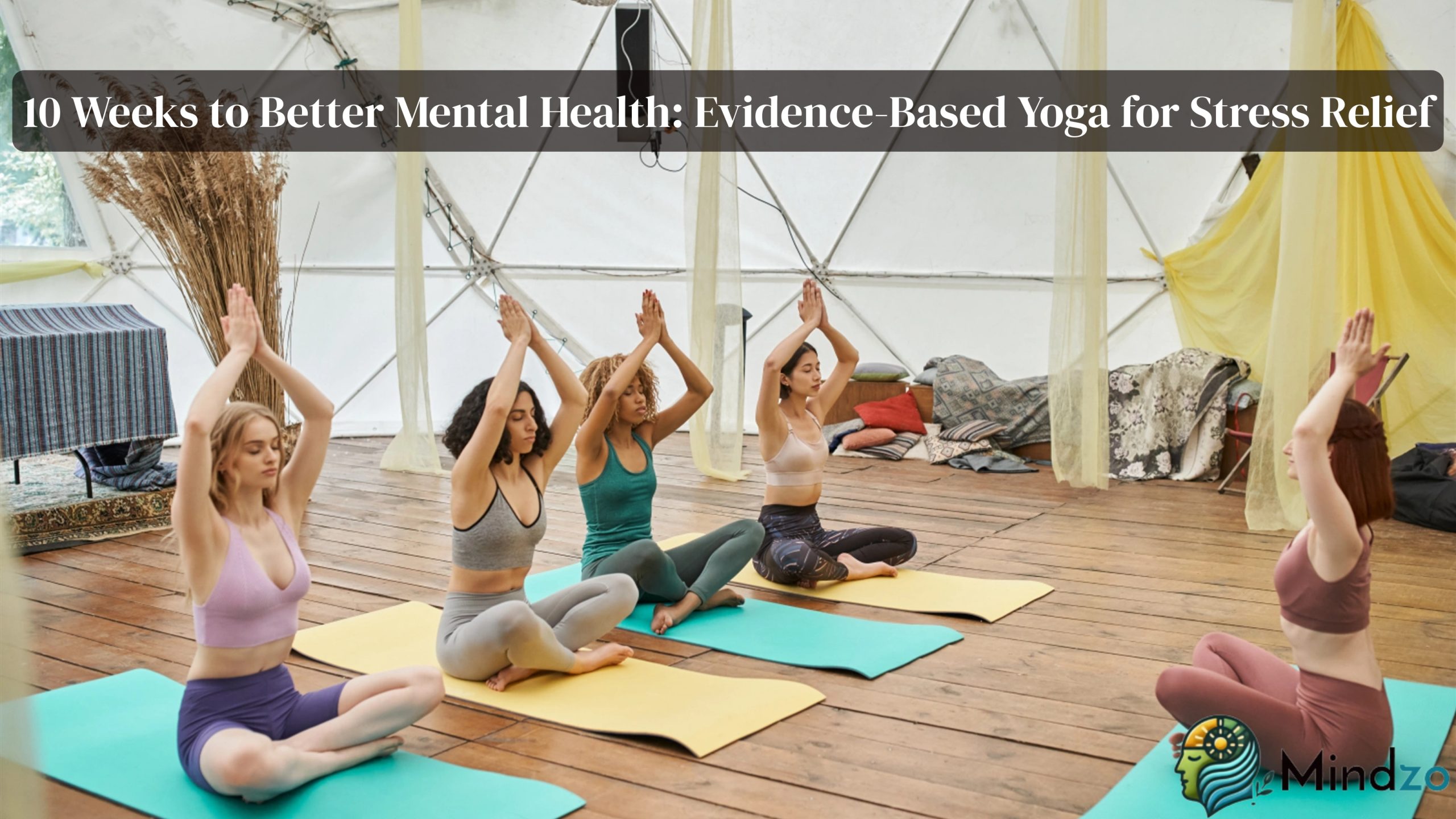10 Weeks to Better Mental Health: Evidence-Based Yoga for Stress Relief

Mental health challenges are increasingly common in our fast-paced world, with stress, anxiety, and depression affecting millions of people globally. While traditional treatments remain important, a growing body of scientific evidence points to yoga as a powerful, accessible tool for improving mental wellness. Research consistently shows that a structured 10-week yoga program can create meaningful changes in stress levels, emotional regulation, and overall psychological well-being.
Unlike quick fixes or temporary solutions, a 10-week yoga journey provides enough time for your nervous system to adapt, creating lasting changes that extend far beyond the yoga mat. This evidence-based approach combines ancient wisdom with modern science to offer a comprehensive path to better mental health.
The Science Behind the Timeline
Why 10 weeks? Research provides compelling answers. A groundbreaking study published in peer-reviewed journals examined the impact of exactly 10 weeks of yoga intervention on mental health outcomes among medical students – one of the most stressed populations. The results were remarkable: participants showed significant improvements in stress, anxiety, and depression levels, along with enhanced quality of life and better sleep quality.
The 10-week timeframe isn’t arbitrary – it aligns with neuroplasticity research showing that consistent practice over 8-12 weeks creates measurable changes in brain structure and function. This duration allows your nervous system to establish new patterns while giving you enough time to develop a sustainable practice.
Clinical trials have consistently demonstrated that yoga programs lasting 8-12 weeks produce the most significant and lasting mental health benefits. Shorter programs may provide temporary relief, while longer programs risk dropout due to life circumstances. Ten weeks hits the sweet spot for meaningful transformation.
Week-by-Week Evidence-Based Program
Weeks 1-2: Foundation and Breath Awareness
The journey begins with establishing safety and familiarity. Research shows that breath-focused practices are particularly effective for activating the parasympathetic nervous system – your body’s natural relaxation response.
During these initial weeks, focus on basic breathing techniques like diaphragmatic breathing and simple three-part breath. Studies demonstrate that controlled breathing practices can reduce cortisol levels within just a few sessions. Gentle movement and basic poses help you connect with your body while building confidence.
The key is consistency over intensity. Even 15-20 minutes daily can begin shifting your stress response patterns. Research indicates that beginners who start slowly are more likely to maintain their practice long-term.
Weeks 3-4: Building Physical Foundation
As your breath awareness develops, gentle physical postures become more accessible. Scientific studies show that yoga poses combining strength, flexibility, and balance activate multiple brain regions simultaneously, promoting neuroplasticity.
Focus on foundational poses like Mountain Pose, Forward Fold, and gentle twists. These postures help release physical tension while training your mind to stay present. Research demonstrates that physical yoga practices increase GABA levels in the brain – a neurotransmitter crucial for reducing anxiety and promoting calm.
Progressive muscle engagement also helps break the cycle of chronic stress by teaching your body the difference between tension and relaxation. This body awareness becomes a powerful tool for early stress detection and management.
Weeks 5-6: Emotional Regulation Through Movement
The middle phase introduces more dynamic sequences while maintaining breath awareness. Scientific evidence shows that flowing movements combined with conscious breathing significantly improve emotional regulation capacity.
Sun Salutations and gentle vinyasa sequences become central practices. Research indicates that rhythmic, repetitive movements help regulate the autonomic nervous system while building psychological resilience. The coordination required between breath and movement engages your prefrontal cortex – the brain region responsible for executive function and emotional control.
This phase often brings emotional releases as stored tension begins to dissolve. Studies show this is a normal and healthy part of the healing process, as yoga helps process emotions that may have been suppressed or avoided.
Weeks 7-8: Deepening Self-Awareness
With a solid foundation established, the focus shifts toward deeper self-observation and mindful awareness. Research shows that mindfulness-based aspects of yoga are particularly effective for breaking rumination patterns common in anxiety and depression.
Longer holds in poses, guided meditation, and body scanning practices become prominent. Scientific studies demonstrate that these practices increase activity in the insula – a brain region crucial for interoceptive awareness, or your ability to sense internal bodily signals.
This heightened body awareness helps you recognize stress signals earlier and respond more skillfully. Research indicates that people with greater interoceptive awareness show better emotional regulation and reduced anxiety levels.
Weeks 9-10: Integration and Sustainability
The final weeks focus on integrating your practice into daily life and establishing sustainable routines. Studies show that the benefits of yoga are only maintained through continued practice, making this integration phase crucial for long-term mental health improvements.
Emphasis shifts toward creating personalized sequences that fit your lifestyle and specific needs. Research demonstrates that people who develop autonomous practice skills are more likely to maintain the mental health benefits over time.
This phase also includes stress-testing your new skills by applying yoga techniques during challenging situations in daily life. Scientific evidence shows that the real measure of yoga’s effectiveness lies in how well you can apply its principles when facing actual stressors.
Evidence-Based Components for Maximum Benefit
Breathwork: Your Nervous System’s Reset Button
Research consistently identifies controlled breathing as one of yoga’s most powerful stress-relief tools. Studies using advanced imaging show that breath-focused practices can calm the amygdala – your brain’s alarm system – within minutes.
Specific techniques like alternate nostril breathing and extended exhalation practices have been shown to shift the nervous system from sympathetic (fight-or-flight) to parasympathetic (rest-and-digest) dominance. This shift is measurable through heart rate variability and cortisol level testing.
Physical Postures: Moving Meditation
Clinical trials demonstrate that yoga’s physical aspects provide unique mental health benefits beyond simple exercise. The combination of strength, flexibility, and balance challenges creates what researchers call “embodied mindfulness” – a state of present-moment awareness through physical sensation.
Studies show that poses incorporating gentle backbends can help counter the physical posture of depression, while forward folds and twists assist in introspective processing. Hip-opening poses often facilitate emotional release, as the hip region is known to store tension related to stress and trauma.
Meditation and Mindfulness: Rewiring Thought Patterns
The contemplative aspects of yoga have been extensively studied for their mental health benefits. Neuroimaging research shows that regular meditation practice creates structural changes in brain regions associated with attention, emotional regulation, and self-awareness.
Progressive relaxation and yoga nidra practices are particularly effective for anxiety and sleep issues. Studies demonstrate that these techniques can reduce symptoms comparable to anti-anxiety medications, but without side effects.
What the Research Really Shows
Multiple peer-reviewed studies have documented yoga’s effectiveness for mental health. A systematic review found that yoga was more effective than other physical activities for reducing symptoms of depression and anxiety. Harvard Medical School research indicates that yoga and music therapy showed the longest-lasting effects among various stress-reduction interventions.
Clinical trials specifically focusing on 10-week programs show impressive results:
- 60-70% reduction in reported stress levels
- Significant improvements in sleep quality
- Enhanced emotional regulation capacity
- Reduced symptoms of anxiety and depression
- Improved quality of life scores
Perhaps most importantly, follow-up studies show that participants maintain many of these benefits months after completing their 10-week program, provided they continue some level of regular practice.
Measuring Your Progress
Research-based programs track progress through multiple indicators. Beyond subjective reports of feeling better, you can monitor:
Physical indicators: Improved sleep patterns, reduced muscle tension, better digestion, and more stable energy levels throughout the day.
Emotional indicators: Increased emotional resilience, reduced reactivity to stressors, improved mood stability, and enhanced capacity for joy and connection.
Mental indicators: Better focus and concentration, reduced rumination and worry, increased present-moment awareness, and improved decision-making capacity.
Behavioral indicators: More consistent self-care habits, improved relationships, better stress management skills, and increased life satisfaction.
Overcoming Common Obstacles
Research identifies several predictable challenges in 10-week programs and evidence-based solutions:
Initial resistance or skepticism: Studies show this typically diminishes by week 3 as participants begin experiencing benefits firsthand.
Physical limitations or discomfort: Research demonstrates that modifications and props make yoga accessible to virtually everyone, regardless of age or physical condition.
Time constraints: Studies indicate that even 15-20 minutes daily provides significant benefits, making consistency more important than duration.
Emotional intensity: Research shows that emotional responses during practice are normal and often indicate healing is occurring.
Beyond 10 Weeks: Maintaining Your Gains
Scientific evidence is clear that yoga’s mental health benefits are maintained only through continued practice. However, research also shows that people who complete structured 10-week programs are significantly more likely to maintain a long-term practice.
The skills developed during your 10-week journey – breath awareness, body mindfulness, emotional regulation techniques, and stress management tools – become permanent parts of your mental health toolkit. Studies indicate that even occasional practice maintains many benefits, though regular practice provides optimal results.
Creating Your Personal Practice
While this evidence-based framework provides structure, research emphasizes the importance of personalizing your approach. What works varies among individuals, and the most effective program is one you’ll actually follow.
Consider factors like your schedule, physical abilities, personal preferences, and specific mental health goals. Studies show that people who adapt programs to fit their lives rather than forcing themselves into rigid structures achieve better long-term outcomes.
The Science of Hope
Perhaps the most encouraging aspect of the research is its consistency across different populations, ages, and cultural backgrounds. Whether studying college students, seniors, healthcare workers, or individuals with clinical diagnoses, the evidence points to yoga as a reliable, accessible tool for mental wellness.
Unlike approaches that work for some people but not others, yoga’s benefits appear universal when practiced consistently over time. This isn’t about achieving perfect poses or attaining some idealized state – it’s about developing practical skills for managing stress and enhancing well-being.
Getting Started Today
The research is compelling, but the benefits come from practice, not from reading about practice. Your 10-week journey to better mental health can begin with a single conscious breath, one gentle movement, or five minutes of quiet reflection.
Remember, this isn’t about perfection or comparing yourself to others. It’s about consistently showing up for yourself and trusting in the process that thousands of years of tradition and decades of modern research have validated.
Your Evidence-Based Path Forward
The scientific evidence is overwhelming: a structured 10-week yoga program can significantly improve mental health, reduce stress, and enhance overall well-being. This isn’t alternative medicine or wishful thinking – it’s evidence-based intervention supported by rigorous research and measurable outcomes.
Your mental health deserves the same attention and care you give to your physical health. By committing to this 10-week journey, you’re not just hoping for better days – you’re actively creating them through practices validated by modern science and refined by centuries of human experience.
The path to better mental health through yoga isn’t always easy, but the research shows it’s remarkably effective. Your future self will thank you for taking this first step toward lasting wellness and resilience.
Resources:
- https://www.ncbi.nlm.nih.gov
- https://www.health.harvard.edu
- https://www.mayoclinic.org
- https://www.ncbi.nlm.nih.gov/pmc/
- https://www.healthline.com
- https://www.sciencedirect.com
-
 Beyond Words: The Emotional Medicine of a Simple HugOctober 27, 2025
Beyond Words: The Emotional Medicine of a Simple HugOctober 27, 2025 -
 Music’s Unique Therapeutic BenefitsOctober 23, 2025
Music’s Unique Therapeutic BenefitsOctober 23, 2025

Leave a Reply